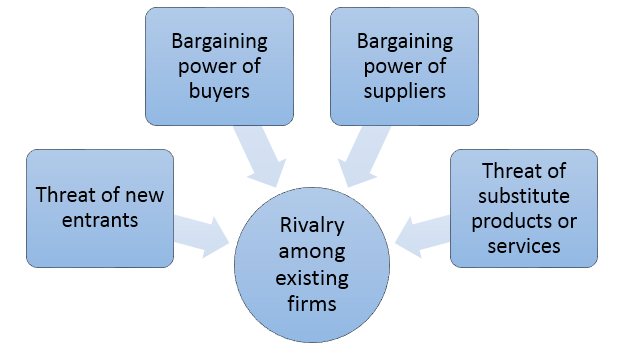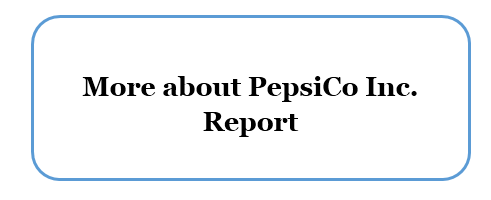PepsiCo Porter’s Five Forces Analysis
Porter’s Five Forces analytical framework developed by Michael Porter (1979)[1] focus upon five separate forces that shape the overall intensity of competition in the industry. These forces are represented in Figure 1 below:
Figure 1. PepsiCo Porter’s Five Forces
Bargaining power of PepsiCo suppliers is insignificant. The main ingredients used by PepsiCo to produce its beverages, food and snacks include apple, orange and pineapple juice and other juice concentrates, aspartame, corn, corn sweeteners, flavorings, flour, grapefruit and other fruits, oats, oranges, potatoes, raw milk, rice, seasonings, sucralose, sugar, vegetable and essential oils, and wheat [2]
PepsiCo purchases from a large number of suppliers and the bargaining power of each individual supplier is low due to the lack of uniqueness of products supplied. Furthermore, high level of importance for each supplier to have business with PepsiCo and PepsiCo’s ability to switch suppliers can be specified as important factors that reduce PepsiCo supplier bargaining power.
Rivalry among existing firms is highly intensive. Beverage, food and snack manufacturing industry is highly competitive. The major brands competing with PepsiCo include but are not limited to The Coca Cole Company, DPSG, Kellogg Company, The Kraft Heinz Company, Mondelez International Inc., Monster Beverage Corporation, Nestlé S.A., Red Bull GmbH and Snyder’s-Lance, Inc.
The Coca Cola Company is PepsiCo’s primary competitor and the US market share of these two brands amount to 20 per cent and 24 per cent respectively.[3] On the global scale, on the other hand, Coca-Cola has a leadership position with a market share of about 48.6 per cent compared to PepsiCo’s market share of 20.5 per cent (see Figure 2 below).
Figure 2. Market share of carbonated beverages worldwide as of 2015[4]
Threat of substitute products for PepsiCo is significant. The range substitutes for PepsiCo’s beverage products include tea, coffee, tap water and a wide range of other drinks and beverages. Nuts, chocolate and various foods represent substitute products for PepsiCo’s snack and food product category. It is important to note that the majority of substitutes of PepsiCo food, snacks and beverages are healthier choices from the nutritional point of view and this fact further increases the threat of substitute products for PepsiCo. Moreover, there is no cost for consumers to switch to substitute products and it can be argued that buyers’ propensity to substitute may be increasing due to their increasing awareness about negative health implications of carbonated drinks and salty snacks and food…
PepsiCo Inc. Report contains a detailed discussion of PepsiCo Porter’s Five Forces Analysis. The report also illustrates the application of the major analytical strategic frameworks in business studies such as SWOT, PESTEL, Value Chain Analysis and McKinsey 7S Model on PepsiCo. Moreover, the report contains analysis of PepsiCo’s marketing strategy, discusses leadership and organizational structure and addresses the issues of corporate social responsibility.
[1] Porter, M. (1979) “How Competitive Forces Shape Strategy” Harvard Business Review
[2] Annual Report (2015) PepsiCo
[3] Annual Report (2015) PepsiCo
[4] Statista (2016)



